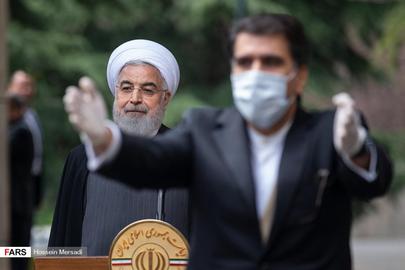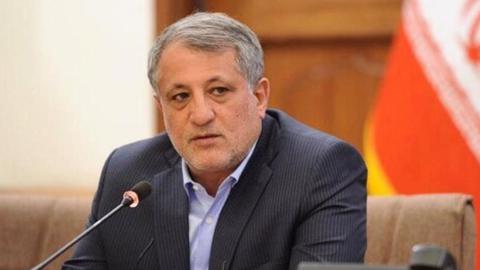President Rouhani is taking further steps to open Iran’s economy as coronavirus cases increase around the country. Speaking at a National Coronavirus Taskforce meeting on July 11, Rouhani said it was not reasonable to expect the economy to be shut down for six months, and that a total lockdown would not be possible in Iran anyway. He said measures had to be put in place to ensure business and education could reopen, while ensuring the public’s health was protected.
Rouhani’s government has consistently presented data about the outbreak of coronavirus that downplays the impact of the crisis, despite reports from several provincial officials that indicate that many parts of the country are in a state of emergency. The health ministry spokesperson’s daily announcements follow an obvious policy of distorting figures and denying the pandemic’s effect on the country. Recently, the spokesperson, Dr. Sima Sadat Lari, failed to mention the situation in a number of hard-hit provinces, an omission that makes it clear that Tehran is not talking to local experts.
Health minister Saeed Namaki has criticized government pressure to re-open businesses, mosques and other venues, but President Rouhani defended the reopenings and his policies for handling the pandemic. He has also repeatedly blamed the resurgence of the virus on members of the public who he says have refused to observe health protocols. He did, however, concede that public gatherings should be banned until further notice.
Many provinces are buckling under the pressure of rising cases, hospitalizations, and deaths, with governors announcing a “red” state of alert. Other provinces are on “orange” alert, and officials appear to be trying to prevent the situation from getting worse.
Mohsen Hashemi, president of Tehran City Council, called for a two-week vacation to be declared to protect the capital and the province from a worsening outbreak of coronavirus. He said the public’s cooperation, including a commitment not to travel, was vital. At the same time, he acknowledged that such measures could only take place with the endorsement of the National Coronavirus Taskforce, which has the legal authority to make such decisions.
As the second wave of coronavirus in Tehran accelerated, the government increased the number of 16- and 24-hour screening centers from 56 to 90. The centers separate individuals with coronavirus symptoms from other patients and refer them to doctors for a full diagnosis.
As Iranian politicians returned to parliament, arrangements were made for newly-elected members to visit the Supreme Leader — a custom usually carried out in the early weeks of any new session — online. Mohammad Saleh Jokar, chairman of the Internal Policies Committee, said the video conference with Ayatollah Khamenei took place on July 12.
Rouhani asked the health ministry to draw up guidelines for the nationwide university entrance exams to go ahead, and health minister Saeed Namaki announced he, the minister of science and officials from the National Testing Organization would decide the details. More than two million students have registered to take the exams, and Iranian officials have repeatedly issued contradictory statements about how they should be managed in the wake of the pandemic.
Provinces Round-up
The crisis has been made worse by a lack of clear health policy in many provinces in Iran, particularly in the south. Cases continue to rise and restrictions on movement are still in place in Bushehr, Kohgiluyeh and Boyer Ahmad, and Ilam. In Hamedan province, the governor has called for a partial lockdown in a number of cities and towns.
Dozens of cities, towns and even entire provinces have been classified as “red” zones or areas in a state of emergency, including eight of the nine cities of Bushehr province, and all of Ilam province, which entered into a second week as a “red” zone on July 11. Ninety percent of the province’s population live in high-risk areas. Ten cities in Mazandaran provinces were declared “red” in less than a week. The number of patients admitted daily in hospitals under the care of Mazandaran University of Medical Sciences rose from 300 to 1000. To prevent a repeat of the disastrous situation in Mazandaran in March and April, the health minister ordered his senior deputy Iraj Harirchi to personally review the situation.
And the number of “red” areas continues to rise. Until July 10, the health ministry classified the city of Ardebil as an “orange” zone — less at risk — but it is now also considered to be "red", with 70 percent of the city’s population people living in high-risk areas. The province is now on a second peak of the epidemic according to the data, said Shahram Habibzadeh, president of Ardebil University of Medical Science.
According to the health ministry, Hamedan province as a whole is at less risk, neither a “red” or “orange” zone. And yet the provincial governor Saeed Shahrokhi announced that the number of infections and fatalities has grown four times and, to prevent further spread of the virus, certain businesses and activities should be locked down for a week in the “red” cities of the province, including Hamedan, Malayer, Tuyserkan and Nahavand.
Cases in the province of Kohgiluyeh and Boyer Ahmad continue to rise and Hossein Kalantari, the governor of the province, has said that fatalities are rising at an alarming rate.
Ilam University of Medical Sciences reported that 160 members of the province’s medical personnel had been infected with coronavirus, and the university president Dr. Mohammad Karimian warned that if the situation continued, it would be impossible to control the epidemic.
In response to the increase in the number of coronavirus patients in Fars province, five state hospitals and two private hospitals have allocated 818 regular beds and 129 specially equipped beds to these patients and a recovery center with 60 beds has been set up, according to Anayatollah Rahimi, gthe overnor of Fars. And Masoud Torabi, director of Fars Blood Transfusions Organization, warned that the blood reserves in the province are alarmingly low. The Ardebil province’s Blood Transfusions Organization also announced that it has an emergency need for blood and asked those who have recovered from Covid-19 to donate to help treat new patients.
Official Figures: Again Misleading
The data presented by the health ministry continues to contradict information on the ground. In the 24-hour period covering July 10 and Jully 11, the ministry spokeswoman Dr. Sima Sadat Lari, announced that 2,397 new Covid-19 patients have been identified, bringing the total of infections since the epidemic started to 255,635. She said that 1,739 of the new cases had been hospitalized and reported that, in the same 24-hour period, 188 patients died from coronavirus, so the total death toll was 12,635 as of July 11.
According to Sadat Lari, the provinces of Khuzestan, East Azerbaijan, Razavi Khorasan, Hormozgan and North Khorasan are now “red” zones and the provinces of Tehran, Alborz, Lorestan, South Khorasan, Kohgiluyeh and Boyer Ahmad, Zanjan, Isfahan, Mazandaran, Golestan and Ilam are in an “orange” state.
It is not clear why the spokeswoman failed to include the provinces of Bushehr, Ardebil and Ilam in the list of red provinces, despite the fact that health officials in these provinces have announced that they are in a red state. And why are Isfahan, Fars, West Azerbaijan, Kerman, Yazd, Kurdistan, Hamedan and Kermanshah missing from her list of “orange” zones? Is it possible that a “red” province such as Kurdistan, Kermanshah or West Azerbaijan could move straight to being classified as a “yellow” (low alert) or “white” (very low risk) zone without moving through the “orange” or “serious risk” classification first? Can it be that provincial health officials see the situation differently than the health ministry in Tehran, even though they are all part of the same organization?
This is part of IranWire's coronavirus chronology. Read the full chronology
visit the accountability section
In this section of Iran Wire, you can contact the officials and launch your campaign for various problems





























comments